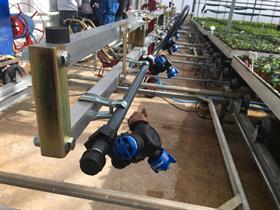
While biopesticides and biological controls are becoming an obvious choice, low efficacy and variable results are still holding some growers back.
That is the challenge being tackled by Amber, a five-year AHDB programme investigating how the application of non-chemical crop protection products can be improved to gain better results.
Unlike chemical products, which have reliable and instantaneous results, biopesticides often take longer to work, and they are also dependent on the size of the pest population. Growers must apply biological solutions before the point of exponential growth in a population, explains Dave Chandler of the University of Warwick, and project lead on the Amber project.
“There is a significant opportunity to improve efficacy in biopesticides,” he says. “They require much more knowledge than chemical pesticides, and growers are having much more variable results.”
Spray applications, both in terms of technique and equipment, are a vital factor, with the type of spray nozzle, pressure and water volume all found to affect the results of a biopesticide product, as well as basic maintenance routines. “No one calibrates their sprayer – their nozzles are full of gunk. You can’t get away with that with biopesticides,” adds Chandler.
Joe Martin, senior crop protection scientist at AHDB, says: “From these trials it’s quite clear there’s a lot of work to do in terms of improved application techniques. Water volume has been a key one. Lots of growers are following label recommendations and using too much. It could be that the manufacturers use a common rate per hectare, which doesn’t fit brilliantly for crops in glasshouses.”
Martin says biopesticides are used predominantly in protected crops, where they work well on pest and disease when applied correctly, and are less useful in combating weeds. Outdoor veg growers are certainly “interested” in the results of trials, he continues, but concerns over the varying efficacy and the fact that chemicals are still the primary crop protection in fields are holding them back. Part two of the Amber project will develop a biopesticide toolkit, and in the meantime growers are encouraged to attend workshops and follow trial results.
Just how important it is for growers to understand biopesticides is summarised by Chandler, who says the grower community will soon have “no choice”. “You will be using them. Chemicals are disappearing rapidly. The EU stipulates by law that biopesticides are used in preference to chemical options. You have to get on top of your spray applications,” he adds.



